Edmonton

Edmonton

Edmonton | |
|---|---|
Provincial capital city | |
| City of Edmonton | |
 From top left: Downtown Edmonton, Fort Edmonton Park, Legislature Building, Law Courts, Rogers Place, High Level Bridge, Muttart Conservatory | |
| Nicknames: Canada's Festival City, City of Champions, The Oil Capital of Canada more...[1] | |
| Motto(s): Industry, Integrity, Progress | |
| Coordinates:53°32′N 113°30′W [319] | |
| Country | Canada |
| Province | Alberta |
| Region | Edmonton Metropolitan Region |
| Census division | 11 |
| Founded | 1795 |
| Incorporated[2][3] | |
| • Town | January 9, 1892 |
| • City | October 8, 1904 |
| Amalgamated[2] | February 12, 1912 |
| Named for | Edmonton, London |
| Government | |
| • Mayor | Don Iveson (Past mayors) |
| • Governing body | Edmonton City Council
|
| • Manager | Linda Cochrane [4] |
| • MPs | List of MPs
|
| • MLAs | List of MLAs
|
| Area | |
| • Land | 767.85 km2(296.47 sq mi) |
| • Urban | 572.69 km2(221.12 sq mi) |
| • Metro | 9,438.86 km2(3,644.36 sq mi) |
| Elevation | 645 m (2,116 ft) |
| Population | |
| • Provincial capital city | 932,546 |
| • Density | 1,360.9/km2(3,525/sq mi) |
| • Urban | 1,062,643 |
| • Urban density | 1,855.5/km2(4,806/sq mi) |
| • Metro | 1,321,426 (6th) |
| • Metro density | 140.0/km2(363/sq mi) |
| • Municipal census (2019) | 972,223[10] |
| Demonym(s) | Edmontonian |
| Time zone | UTC−7 (MST) |
| • Summer (DST) | UTC−6 (MDT) |
| Forward sortation areas | T5A - T6Y |
| Area codes | 780, 587, 825 |
| NTS Map | 083H11 |
| GNBC Code | IACMP |
| Median income (all census families) | C$ 88,075 (2011)[11] |
| Average income per household | C$ 103,856 (est. 2011) |
| Public transit | Edmonton Transit Service |
| Highways | 2, 14, 15, 16, 16A, 19, 28, 28A, 37, 100, 216 |
| Waterways | North Saskatchewan River, Big Lake, Whitemud Creek, Blackmud Creek, Mill Creek, Fulton Creek |
| GDP | US$ 88.2 billion[11] |
| GDP per capita | US$ 62,832[12] |
| Website | Official website [320] |
Edmonton (/ˈɛdməntən/ (listen); Cree: ᐊᒥᐢᑲᐧᒋᐊᐧᐢᑲᐦᐃᑲᐣ;[13] Blackfoot: Omahkoyis[14]) is the capital city of the Canadian province of Alberta. Edmonton is on the North Saskatchewan River and is the centre of the Edmonton Metropolitan Region, which is surrounded by Alberta's central region. The city anchors the north end of what Statistics Canada defines as the "Calgary–Edmonton Corridor".[15]
The city had a population of 932,546 in 2016, making it Alberta's second-largest city and Canada's fifth-largest municipality.[5] Also in 2016, Edmonton had a metropolitan population of 1,321,426, making it the sixth-largest census metropolitan area (CMA) in Canada.[7] Edmonton is North America's northernmost metropolitan area with a population over one million. A resident of Edmonton is known as an Edmontonian.[16]
Edmonton's historic growth has been facilitated through the absorption of five adjacent urban municipalities (Strathcona, North Edmonton, West Edmonton, Beverly and Jasper Place)[17] in addition to a series of annexations through 1982,[18] and the annexation of 8,260 ha (82.6 km2) of land from Leduc County and the city of Beaumont on January 1, 2019.[8] Known as the "Gateway to the North",[19] the city is a staging point for large-scale oil sands projects occurring in northern Alberta and large-scale diamond mining operations in the Northwest Territories.[20]
Edmonton is a cultural, governmental and educational centre. It hosts a year-round slate of festivals, reflected in the nickname "Canada's Festival City".[1] It is home to North America's largest mall, West Edmonton Mall (the world's largest mall from 1981 until 2004),[21] and Fort Edmonton Park, Canada's largest living history museum.[22]
Edmonton | |
|---|---|
Provincial capital city | |
| City of Edmonton | |
 From top left: Downtown Edmonton, Fort Edmonton Park, Legislature Building, Law Courts, Rogers Place, High Level Bridge, Muttart Conservatory | |
| Nicknames: Canada's Festival City, City of Champions, The Oil Capital of Canada more...[1] | |
| Motto(s): Industry, Integrity, Progress | |
| Coordinates:53°32′N 113°30′W [319] | |
| Country | Canada |
| Province | Alberta |
| Region | Edmonton Metropolitan Region |
| Census division | 11 |
| Founded | 1795 |
| Incorporated[2][3] | |
| • Town | January 9, 1892 |
| • City | October 8, 1904 |
| Amalgamated[2] | February 12, 1912 |
| Named for | Edmonton, London |
| Government | |
| • Mayor | Don Iveson (Past mayors) |
| • Governing body | Edmonton City Council
|
| • Manager | Linda Cochrane [4] |
| • MPs | List of MPs
|
| • MLAs | List of MLAs
|
| Area | |
| • Land | 767.85 km2(296.47 sq mi) |
| • Urban | 572.69 km2(221.12 sq mi) |
| • Metro | 9,438.86 km2(3,644.36 sq mi) |
| Elevation | 645 m (2,116 ft) |
| Population | |
| • Provincial capital city | 932,546 |
| • Density | 1,360.9/km2(3,525/sq mi) |
| • Urban | 1,062,643 |
| • Urban density | 1,855.5/km2(4,806/sq mi) |
| • Metro | 1,321,426 (6th) |
| • Metro density | 140.0/km2(363/sq mi) |
| • Municipal census (2019) | 972,223[10] |
| Demonym(s) | Edmontonian |
| Time zone | UTC−7 (MST) |
| • Summer (DST) | UTC−6 (MDT) |
| Forward sortation areas | T5A - T6Y |
| Area codes | 780, 587, 825 |
| NTS Map | 083H11 |
| GNBC Code | IACMP |
| Median income (all census families) | C$ 88,075 (2011)[11] |
| Average income per household | C$ 103,856 (est. 2011) |
| Public transit | Edmonton Transit Service |
| Highways | 2, 14, 15, 16, 16A, 19, 28, 28A, 37, 100, 216 |
| Waterways | North Saskatchewan River, Big Lake, Whitemud Creek, Blackmud Creek, Mill Creek, Fulton Creek |
| GDP | US$ 88.2 billion[11] |
| GDP per capita | US$ 62,832[12] |
| Website | Official website [320] |
History
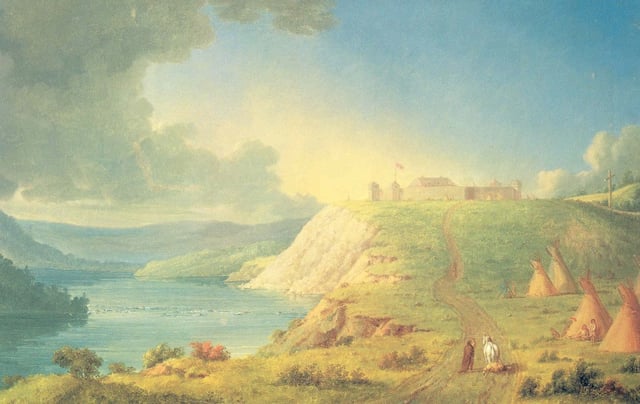
The last of five Fort Edmontons was constructed in 1830. It was the third to be built within present day Edmonton.
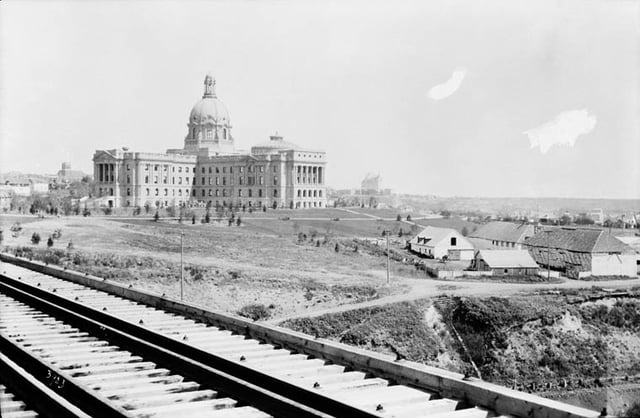
The completed Alberta Legislature Building in 1914, just above the last Fort Edmonton. The city was selected as Alberta's capital in 1905.
The earliest known inhabitants arrived in the area that is now Edmonton around 3,000 BC and perhaps as early as 12,000 BC when an ice-free corridor opened as the last glacial period ended and timber, water, and wildlife became available in the region.[23]
In 1754, Anthony Henday, an explorer for the Hudson's Bay Company (HBC), may have been the first European to enter the Edmonton area.[24] His expeditions across the Canadian Prairies were mainly to seek contact with the aboriginal population for establishing the fur trade, as the competition was fierce between the Hudson's Bay Company and the North West Company. By 1795, Fort Edmonton was established on the river's north bank as a major trading post for the Hudson's Bay Company.[25] The new fort's name was suggested by John Peter Pruden after Edmonton, London, the hometown of both the HBC deputy governor Sir James Winter Lake, and Pruden.
In 1876, Treaty 6, which includes what is now Edmonton, was signed between the Aboriginal peoples in Canada (or First Nations) and Queen Victoria as Queen of Canada, as part of the Numbered Treaties of Canada.[26][27] The agreement includes the Plains and Woods Cree, Assiniboine, and other band governments of First Nations at Fort Carlton, Fort Pitt, and Battle River. The area covered by the treaty represents most of the central area of the current provinces of Saskatchewan and Alberta.[28]
The coming of the Canadian Pacific Railway (CPR) to southern Alberta in 1885 helped the Edmonton economy, and the 1891 building of the Calgary and Edmonton (C&E) Railway resulted in the emergence of a railway townsite (South Edmonton/Strathcona) on the river's south side, across from Edmonton. The arrival of the CPR and the C&E Railway helped bring settlers and entrepreneurs from eastern Canada, Europe, U.S. and other parts of the world. The Edmonton area's fertile soil and cheap land attracted settlers, further establishing Edmonton as a major regional commercial and agricultural centre. Some people participating in the Klondike Gold Rush passed through South Edmonton/Strathcona in 1897. Strathcona was North America's northernmost railway point, but travel to the Klondike was still very difficult for the "Klondikers," and a majority of them took a steamship north to the Yukon from Vancouver, British Columbia.[29]
Incorporated as a town in 1892 with a population of 700 and then as a city in 1904 with a population of 8,350,[30] Edmonton became the capital of Alberta when the province was formed a year later, on September 1, 1905.[31] In November 1905, the Canadian Northern Railway (CNR) arrived in Edmonton, accelerating growth.[32]
During the early 1900s, Edmonton's rapid growth led to speculation in real estate. In 1912, Edmonton amalgamated with the City of Strathcona, south of the North Saskatchewan River; as a result, the city extended south of the North Saskatchewan River for the first time.[33]
Just before World War I, the boom ended, and the city's population declined from more than 72,000 in 1914 to less than 54,000 only two years later.[34] Many impoverished families moved to subsistence farms outside the city, while others fled to greener pastures in other provinces.[35] Recruitment to the army during the war also contributed to the drop in population.[36] Afterwards, the city slowly recovered in population and economy during the 1920s and 1930s and took off again during and after World War II.
The Edmonton City Centre Airport opened in 1929,[37] becoming Canada's first licensed airfield.[38] Originally named Blatchford Field in honour of former mayor Kenny Blatchford, pioneering aviators such as Wilfrid R. "Wop" May and Max Ward used Blatchford Field as a major base for distributing mail, food, and medicine to Northern Canada; hence Edmonton's emergence as the "Gateway to the North". World War II saw Edmonton become a major base for the construction of the Alaska Highway and the Northwest Staging Route.[39] The airport was closed in November 2013.[40]
History of municipal governance
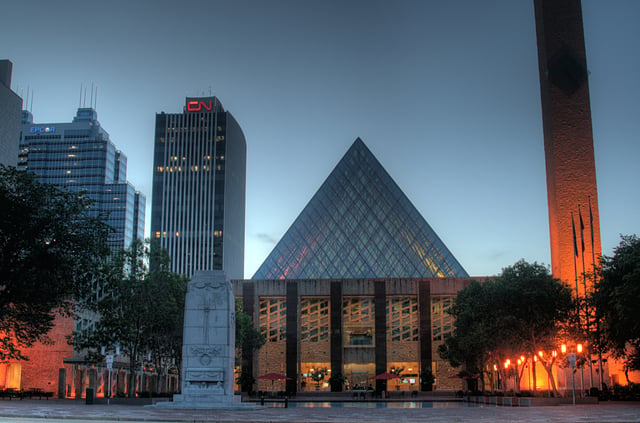
Edmonton City Hall is the home of the municipal government for Edmonton.
In 1892 Edmonton was incorporated as a town. The first mayor was Matthew McCauley, who established the first school board in Edmonton and Board of Trade (later Chamber of Commerce) and a municipal police service.[44] Due to McCauley's good relationship with the federal Liberals, Edmonton maintained economic and political prominence over Strathcona, a rival settlement/town/city on the south side of the North Saskatchewan River.[44] Edmonton was incorporated as a city in 1904 and became Alberta's capital in 1905.
Unions and radical organizations such as the Industrial Workers of the World struggled for progressive social change through the early years, with the first reformer, James East, elected in 1912, followed by the first official Labour alderman, James Kinney, the following year. Many thousands of workers participated in the Edmonton general strike of 1919 and a strong block of Labour representatives were on council after the next election: East, Kinney, Sam McCoppen, Rice Sheppard and Joe Clarke.
The City used Single Transferable Vote (STV), a form of proportional representation, for elections from 1923 to 1927, in which councillors were elected at large with ranked transferable votes.
Geography
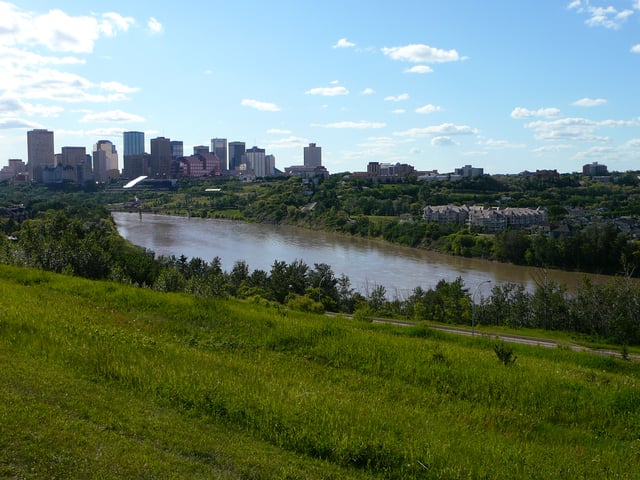
The North Saskatchewan River is a glacier-fed river that bisects the city.
Edmonton is on the North Saskatchewan River, at an elevation of 671 metres (2,201 ft).[31] It is North America's northernmost city with a metropolitan population over one million. It is at the same latitude as Hamburg (Germany); Dublin (Ireland); Manchester (United Kingdom); and Magnitogorsk (Russia). It is south of Alberta's geographic centre, which is near the Hamlet of Fort Assiniboine.[48] The terrain in and around Edmonton is generally flat to gently rolling, with ravines and deep river valleys, such as the North Saskatchewan River valley.[49] The Canadian Rockies are about 220 km (140 mi) to the southwest.
The North Saskatchewan River originates at the Columbia Icefield in Jasper National Park and bisects the city. Before the construction of two reservoirs near the mountains, it would sometimes flood Edmonton's river valley, most notably in the North Saskatchewan River flood of 1915. It empties via the Saskatchewan River, Lake Winnipeg, and the Nelson River into Hudson Bay.[50] It runs from southwest to northeast and is fed by numerous creeks throughout the city, such as Mill Creek, Whitemud Creek and Blackmud Creek; this creates numerous ravines, some of which are used for urban parkland.[51] Edmonton is within the Canadian Prairies Ecozone.[52] Aspen parkland surrounds the city and is a transitional area from the prairies to the south and boreal forest in the north.[53] The aspen woods and forests in and around Edmonton have long since been reduced by farming and other human activities, such as residential and commercial land development as well as oil and natural gas exploration.[54]
Climate

Winters in Edmonton are typically cold and dry.
The city is among the Canadian cities with the coldest winters, though milder than Regina, Saskatoon and Winnipeg,[57] all of which are south of Edmonton. Its average daily temperatures range from a low of −10.4 °C (13.3 °F) in January to a summer peak of 17.7 °C (63.9 °F) in July.[58] With average maximum of 23.1 °C (73.6 °F) in July, and minimum of −14.8 °C (5.4 °F) in January.[59] Temperatures can exceed 30 °C (86 °F) for an average of four to five days anytime from late April to mid-September and fall below −20 °C (−4 °F) for an average of 24.6 days. The highest temperature recorded in Edmonton was 37.2 °C (99.0 °F), on June 29, 1937.[60] On July 2, 2013, a record high humidex of 44 was recorded, due to an unusually humid day with a temperature of 33.9 °C (93.0 °F) and a record high dew point of 23 °C (73.4 °F).[61][62] The lowest temperature ever recorded in Edmonton was −49.4 °C (−56.9 °F), on January 19 and 21, 1886.[63]
Summer lasts from late June until early September, and the humidity is seldom uncomfortably high. Winter lasts from November to March and varies greatly in length and severity. Spring and autumn are both short and highly variable. Edmonton's growing season is from May 9 to September 22;[58][64] it averages 135-140 frost-free days a year.[58][65] At the summer solstice, Edmonton receives 17 hours and three minutes of daylight, with an hour and 46 minutes of civil twilight.[66] On average Edmonton receives 2,299 hours of bright sunshine[67] per year and is one of Canada's sunniest cities.[58]
The summer of 2006 was particularly warm for Edmonton, as temperatures reached 29 °C (84 °F) or higher more than 20 times from mid-May to early September. The winter of 2011–12 was particularly warm; from December 22, 2011, till March 20, 2012, on 53 occasions Edmonton saw temperatures at or above 0.0 °C (32.0 °F) at the City Centre Airport.[68][69][70][71]
Edmonton has a fairly dry climate. On average, it receives 476.9 millimetres (18.78 in) of precipitation, of which 365.7 millimetres (14.40 in) is rain and 111.2 millimetres (4.38 in) is the melt from 123.5 centimetres (48.6 in) of snowfall per annum.[58] Precipitation is heaviest in the late spring, summer, and early autumn. The wettest month is July, while the driest months are February, March, October, and November.[58] In July the mean precipitation is 91.7 mm (3.61 in).[58] Dry spells are not uncommon and may occur at any time of the year. Extremes do occur, such as the 114 mm (4.49 in) of rainfall that fell on July 31, 1953.[58] Summer thunderstorms can be frequent and occasionally severe enough to produce large hail, damaging winds, funnel clouds, and occasionally tornadoes. Twelve tornadoes had been recorded in Edmonton between 1890 and 1989,[72] and eight since 1990.[73] A F4 tornado that struck Edmonton on July 31, 1987, killing 27, was unusual in many respects, including severity, duration, damage, and casualties.[74][75] It is commonly referred to as Black Friday due both to its aberrant characteristics and the emotional shock it generated.[76] Then-mayor Laurence Decore cited the community's response to the tornado as evidence that Edmonton was a "city of champions," which later became an unofficial slogan of the city.[1][77]
A massive cluster of thunderstorms occurred on July 11, 2004, with large hail and over 100 mm (4 in) of rain reported within an hour in many places.[78] This "1-in-200 year event" flooded major intersections and underpasses and damaged both residential and commercial properties. The storm caused extensive damage to West Edmonton Mall; a small glass section of the roof collapsed under the weight of the rainwater, causing water to drain onto the mall's indoor ice rink. As a result, the mall was evacuated as a precautionary measure.[79]
| Climate data for Edmonton (Blatchford Field), elevation: 671 m or 2,201 ft, 1981−2010 normals, extremes 1880−present[304] | |||||||||||||
|---|---|---|---|---|---|---|---|---|---|---|---|---|---|
| Month | Jan | Feb | Mar | Apr | May | Jun | Jul | Aug | Sep | Oct | Nov | Dec | Year |
| Record high humidex | 10.6 | 13.8 | 23.5 | 29.2 | 33.4 | 35.9 | 44.0 | 39.6 | 34.1 | 28.3 | 18.9 | 16.0 | 44.0 |
| Record high °C (°F) | 13.9 (57.0) | 16.7 (62.1) | 23.9 (75.0) | 32.2 (90.0) | 34.4 (93.9) | 37.2 (99.0) | 36.7 (98.1) | 35.6 (96.1) | 33.9 (93.0) | 28.6 (83.5) | 23.3 (73.9) | 16.7 (62.1) | 37.2 (99.0) |
| Average high °C (°F) | −6.0 (21.2) | −2.7 (27.1) | 2.2 (36.0) | 11.2 (52.2) | 17.5 (63.5) | 21.0 (69.8) | 23.1 (73.6) | 22.6 (72.7) | 17.1 (62.8) | 10.4 (50.7) | 0.0 (32.0) | −4.5 (23.9) | 9.3 (48.7) |
| Daily mean °C (°F) | −10.4 (13.3) | −7.6 (18.3) | −2.5 (27.5) | 5.4 (41.7) | 11.5 (52.7) | 15.5 (59.9) | 17.7 (63.9) | 16.9 (62.4) | 11.4 (52.5) | 5.1 (41.2) | −4.1 (24.6) | −8.8 (16.2) | 4.2 (39.6) |
| Average low °C (°F) | −14.8 (5.4) | −12.5 (9.5) | −7.2 (19.0) | −0.5 (31.1) | 5.4 (41.7) | 9.9 (49.8) | 12.3 (54.1) | 11.3 (52.3) | 5.8 (42.4) | −0.2 (31.6) | −8.2 (17.2) | −13.1 (8.4) | −1.0 (30.2) |
| Record low °C (°F) | −49.4 (−56.9) | −49.4 (−56.9) | −40.0 (−40.0) | −26.1 (−15.0) | −12.2 (10.0) | −3.9 (25.0) | −1.7 (28.9) | −3.3 (26.1) | −11.7 (10.9) | −26.1 (−15.0) | −42.2 (−44.0) | −48.3 (−54.9) | −49.4 (−56.9) |
| Record low wind chill | −52.8 | −50.7 | −44.6 | −37.5 | −14.5 | 0.0 | 0.0 | −3.7 | −13.3 | −34.3 | −50.2 | −55.5 | −55.5 |
| Average precipitation mm (inches) | 21.7 (0.85) | 12.0 (0.47) | 15.8 (0.62) | 28.8 (1.13) | 46.1 (1.81) | 77.5 (3.05) | 93.8 (3.69) | 61.9 (2.44) | 43.5 (1.71) | 21.7 (0.85) | 18.0 (0.71) | 15.0 (0.59) | 455.7 (17.94) |
| Average rainfall mm (inches) | 1.3 (0.05) | 0.76 (0.03) | 1.7 (0.07) | 14.5 (0.57) | 40.7 (1.60) | 77.5 (3.05) | 93.8 (3.69) | 61.8 (2.43) | 42.4 (1.67) | 10.9 (0.43) | 1.6 (0.06) | 0.73 (0.03) | 347.8 (13.69) |
| Average snowfall cm (inches) | 24.5 (9.6) | 13.4 (5.3) | 17.4 (6.9) | 15.3 (6.0) | 4.9 (1.9) | 0.0 (0.0) | 0.0 (0.0) | 0.0 (0.0) | 1.0 (0.4) | 11.6 (4.6) | 19.1 (7.5) | 16.4 (6.5) | 123.5 (48.6) |
| Average precipitation days(≥ 0.2 mm) | 11.0 | 7.9 | 8.3 | 8.8 | 11.0 | 14.2 | 14.6 | 11.1 | 9.8 | 8.0 | 8.8 | 9.4 | 122.9 |
| Average rainy days(≥ 0.2 mm) | 1.1 | 0.83 | 1.4 | 5.9 | 10.5 | 14.2 | 14.6 | 11.1 | 9.6 | 5.6 | 1.5 | 0.75 | 77.3 |
| Average snowy days(≥ 0.2 cm) | 10.7 | 7.7 | 7.7 | 4.2 | 1.2 | 0.0 | 0.0 | 0.0 | 0.50 | 3.2 | 7.9 | 9.3 | 52.4 |
| Average relative humidity (%) | 65.2 | 61.2 | 56.5 | 42.9 | 40.4 | 48.2 | 52.6 | 51.4 | 50.1 | 50.5 | 64.7 | 65.4 | 54.1 |
| Mean monthly sunshine hours | 100.8 | 121.7 | 176.3 | 244.2 | 279.9 | 285.9 | 307.5 | 282.3 | 192.7 | 170.8 | 98.4 | 84.5 | 2,344.8 |
| Mean daily sunshine hours | 3.3 | 4.3 | 5.7 | 8.1 | 9.0 | 9.5 | 9.9 | 9.1 | 6.4 | 5.5 | 3.3 | 2.7 | 6.4 |
| Percent possible sunshine | 40.2 | 44.1 | 48.1 | 58.2 | 56.8 | 56.2 | 60.2 | 61.5 | 50.4 | 52.0 | 37.8 | 36.0 | 50.1 |
| Average ultraviolet index | 0 | 1 | 2 | 4 | 5 | 6 | 6 | 5 | 4 | 2 | 1 | 0 | 3 |
| Source: Environment Canada,[58][59] (July record high humidex),[61] Extremes (1880−1943)[80] and Weather Atlas[81] | |||||||||||||
Metropolitan area
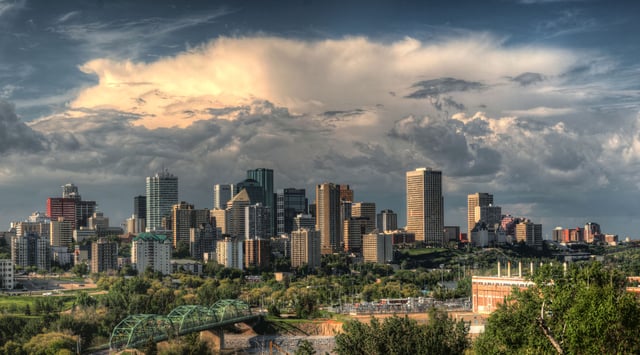
Skyline of downtown Edmonton. Downtown Edmonton is the centre of the Edmonton Metropolitan Region.
Edmonton is at the centre of Canada's sixth-largest census metropolitan area (CMA),[82] which includes Edmonton and 34 other municipalities in the surrounding area.[83] Larger urban communities include Sherwood Park (an urban service area within Strathcona County), the cities of St. Albert, Beaumont, Leduc, Spruce Grove and Fort Saskatchewan, and the towns of Stony Plain, Morinville, and Devon.[84] Major employment areas outside Edmonton but within the CMA include the Nisku Industrial Business Park and the Edmonton International Airport (including a planned inland port logistics support facility in support of the Port Alberta initiative)[85] in Leduc County, the Acheson Industrial Area in Parkland County, Refinery Row in Strathcona County and Alberta's Industrial Heartland[86] within portions of Fort Saskatchewan, Strathcona County and Sturgeon County.[87] Alberta's Industrial Heartland also extends beyond the CMA's northeastern boundary[15] into Lamont County.[87]
The individual economic development interests and costs of service delivery in certain municipalities within the region have led to intermunicipal competition, strained intermunicipal relationships and overall fragmentation of the region. Although several attempts have been made by the City of Edmonton to absorb surrounding municipalities[88] or annex portions of its neighbours,[89] the city has not absorbed another municipality since the Town of Jasper Place joined Edmonton on August 17, 1964,[90] and the city has not annexed land from any of its neighbours since January 1, 1982.[91] After years of mounting pressure in the early 21st century, the Province of Alberta formed the Capital Region Board (CRB) on April 15, 2008.[92] The CRB consists of 24 member municipalities – 22 of which are within the Edmonton CMA and two of which are outside the CMA. The City of Edmonton announced in March 2013 its intent to annex 156 square kilometres of land (including the Edmonton International Airport) from Leduc County.[93]
On November 30, 2016, the City of Edmonton and Leduc County came to an agreement on Edmonton's annexation proposal. The City of Edmonton was poised to annex 29,900 acres (121 km2) of land from Leduc County and Beaumont, including the Edmonton International Airport, as a result.[94]
On January 1, 2019, the City of Edmonton officially annexed 8,260 ha (82.6 km2) from Leduc County and the City of Beaumont, increasing the city's area to 767.85 km2 (296.47 sq mi), with discussions of annexing an additional 2,830 ha (28.3 km2) of Edmonton International Airport land still ongoing.[8]
Neighbourhoods
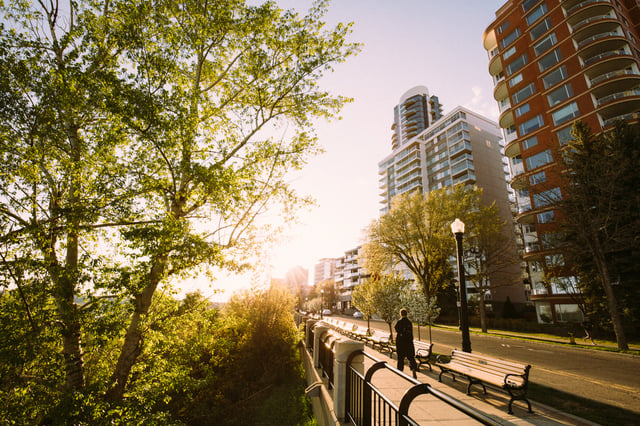
Victoria Promenade in the residential neighbourhood of Oliver. The neighbourhood borders downtown Edmonton.
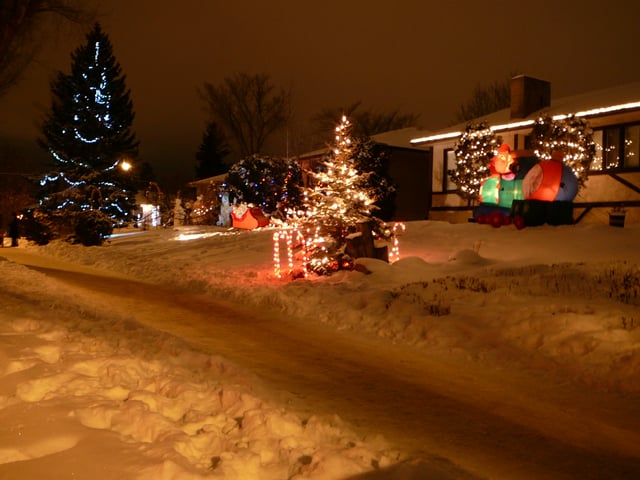
Houses in Crestwood, a residential neighbourhood typical of most suburban areas of Edmonton.
Edmonton's Downtown is within the city's mature area or inner city.[97] It and the surrounding Boyle Street, Central McDougall, Cloverdale, Garneau, McCauley, Oliver, Queen Mary Park, Riverdale, Rossdale, Strathcona and University of Alberta form Edmonton's Central Core.[96] Oliver and Garneau are the city's most populated and most densely populated neighbourhoods respectively. The mature area sector also contains the five former urban municipalities annexed by the city over its history: Beverly, Jasper Place, North Edmonton, Strathcona and West Edmonton (Calder).[18][97]
Larger residential areas within Edmonton's six suburban sectors,[97] each comprising multiple neighbourhoods,[98] include Heritage Valley, Kaskitayo, Riverbend, Terwillegar Heights and Windermere (southwest sector); The Grange, Lewis Farms and West Jasper Place (west sector); Big Lake (northwest sector); Castle Downs, Lake District and The Palisades (north sector); Casselman-Steele Heights, Clareview, Hermitage, Londonderry and Pilot Sound (northeast sector); and Ellerslie, The Meadows, Mill Woods and Southeast Edmonton (southeast sector).[99] Mill Woods is divided into a town centre community (Mill Woods Town Centre)[100] and eight surrounding communities:[101] Burnewood, Knottwood, Lakewood, Millbourne, Millhurst, Ridgewood, Southwood, and Woodvale.[102][103] Each has between two and four neighbourhoods.[98]
Several transit-oriented developments (TOD) have begun to appear along the LRT line at Clareview, with future developments planned at Belvedere (part of the Old Town Fort Road Redevelopment Project).[104] Another TOD, Century Park,[105] is being constructed at the site of what was once Heritage Mall, at the southern end of the LRT line. Century Park will eventually house up to 5,000 residents.[106]
The Edmonton City Centre Airport is planned to be redeveloped into a sustainable community of 30,000 people comprising a transit-oriented mixed use town centre, townhouses, low, medium and high rise apartments, neighbourhood retail and service uses, and a major park.[107]
Edmonton has four major industrial districts: the Northwest Industrial District, the Northeast Industrial District, the Southeast Industrial District, and the emerging Edmonton Energy and Technology Park,[108] which is part of Alberta's Industrial Heartland.[109] The northwest, northeast and southeast districts each have smaller industrial areas and neighbourhoods within them.[98][108]
The city has established 12 business revitalization zones: 124 Street and Area, Alberta Avenue, Beverly, Downtown, Chinatown and Little Italy, Fort Road and Area, Inglewood, Kingsway, North Edge, Northwest Industrial, Old Strathcona and Stony Plain Road.[110]
Demographics
| Federal census population history | ||
|---|---|---|
| Year | Pop. | ±% |
| 1901 | 2,626 | — |
| 1906 | 11,167 | +325.2% |
| 1911 | 24,900 | +123.0% |
| 1916 | 53,846 | +116.2% |
| 1921 | 58,821 | +9.2% |
| 1926 | 65,163 | +10.8% |
| 1931 | 79,197 | +21.5% |
| 1936 | 85,774 | +8.3% |
| 1941 | 93,817 | +9.4% |
| 1946 | 113,116 | +20.6% |
| 1951 | 159,631 | +41.1% |
| 1956 | 226,002 | +41.6% |
| 1961 | 281,027 | +24.3% |
| 1966 | 376,925 | +34.1% |
| 1971 | 438,152 | +16.2% |
| 1976 | 461,361 | +5.3% |
| 1981 | 532,246 | +15.4% |
| 1986 | 573,982 | +7.8% |
| 1991 | 616,741 | +7.4% |
| 1996 | 616,306 | −0.1% |
| 2001 | 666,104 | +8.1% |
| 2006 | 730,372 | +9.6% |
| 2011 | 812,201 | +11.2% |
| 2016 | 932,546 | +14.8% |
| Source: Statistics Canada [111][112][113][114][115][116][117][118][119][120][121] [122][123][124][125][126][127][128][129][130][131][132][133] | ||
The population of the City of Edmonton according to its 2019 municipal census is 972,223,[10] a change of 8.1% from its 2016 municipal census population of 899,447.[134] After factoring in dwellings that did not respond to the municipal census, Edmonton's population is further estimated to be 992,812.[135] Per its municipal census policy,[136] the city's next municipal census is scheduled for 2020.
In the 2016 Census of Population conducted by Statistics Canada, the City of Edmonton recorded a population of 932,546 living in 360,828 of its 387,950 total private dwellings, a change of 14.8% from its 2011 population of 812,201. With a land area of 685.25 km2 (264.58 sq mi), it had a population density of 1,360.9/km2 (3,524.7/sq mi) in 2016.[5]
The 2016 municipal census captured more detailed demographic information on residents, including age and gender, marital status, employment status, length of residency, prior residence, employment transportation mode, citizenship, school residency, economic diversity, city resource access, highest educational attainment, household language and income, as well as dwellings and properties, including ownership, structure and status.[137]
In the 2011 Census, the City of Edmonton had a population of 812,201 living in 324,756 of its 348,672 total dwellings, a change of 11.2% from its 2006 population of 730,372. With a land area of 684.37 km2 (264.24 sq mi), it had a population density of 1,186.8/km2 (3,073.8/sq mi) in 2011.[138] The census also reported that 50.2 percent of the population (407,325) was female while 49.8 percent (404,875) was male. The average age of the city's population was 36.0 years while there was an average 2.5 people per household.[139]
The Edmonton census metropolitan area (CMA) has the fifth-greatest population of CMAs in Canada and the second-greatest in Alberta, but has the largest land area in Canada. It had a population of 1,159,869 in the 2011 Census compared to its 2006 population of 1,034,945. Its five-year population change of 12.1 percent was second only to the Calgary CMA between 2006 and 2011. With a land area of 9,426.73 km2 (3,639.68 sq mi), the Edmonton CMA had a population density of 123.0/km2 (318.7/sq mi) in 2011.[82] Statistics Canada's latest estimate of the Edmonton CMA population, as of July 1, 2016 is 1,363,300 [140]
The Edmonton population centre is the core[141] of the Edmonton CMA. This core includes the cities of Edmonton, Fort Saskatchewan and St. Albert, the Sherwood Park portion of Strathcona County, and portions of Parkland County and Sturgeon County.[142] The Edmonton population centre, the fifth-largest in Canada, had a population of 960,015 in 2011, an 11.3 percent increase over its 2006 population of 862,544.[143]
Ethnicity
According to the 2016 census, 55.8% of Edmonton's population were of European ethnicities, the most frequent of which included the English (16.8%), Scottish (13.8%), German (13.6%), Irish (12.5%), Ukrainian (10.8%), French (9.4%), and Polish (5.1%) origins.[144] Other ethnic groups and origins included, among others:[144]
Canadian at 17.4%;
East and Southeast Asian at 15.9% (including Chinese at 7.4%, Filipino at 6.2%, and Vietnamese at 1.5%);
South Asian at 9.5% (including East Indian at 7.4%);
Aboriginal at 6.4% (including First Nations at 4% and Métis at 2.7%);
African at 6.1%;
Latin, Central and South American at 2.3%;
West Central Asian and Middle Eastern at 4% (including Lebanese at 1.5%); and
Caribbean at 1.4%.
Religion
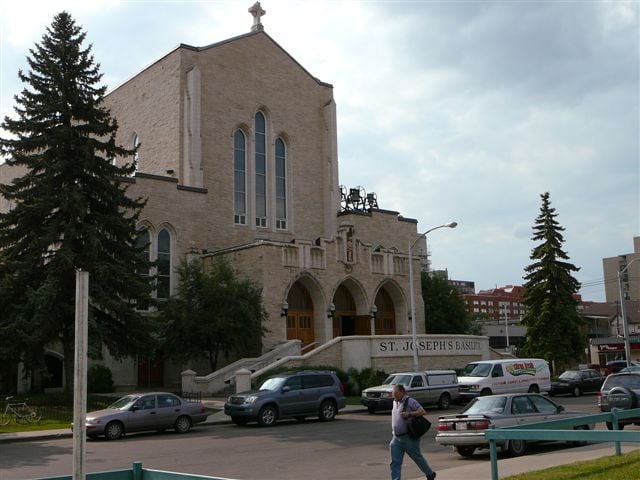
St. Joseph's Basilica is the only basilica in Western Canada. In 2011, 26.2 percent of residents of Edmonton identified as Catholic.
Edmonton is home to members of a number of world religions. According to the 2011 Canadian Household Survey, 59.1 percent of metropolitan Edmonton residents identify as Christian. Significant religious minorities include Muslims (4.1 percent), Sikhs (1.8 percent), Buddhists (1.5 percent), Hindus (1.4 percent), Jewish people (0.3 percent), and practitioners of traditional Aboriginal spirituality (0.2 percent). Those belonging to smaller religions account for 0.5 percent, while 31.1 percent profess no religious affiliation.[146]
Within Christianity, major denominations include the Roman Catholic Church (44.4 percent of self-identified Christians) and the United Church (10.5 percent).[146] Edmonton is home to four major cathedrals, with St. Joseph's Basilica seating the Roman Catholic Archdiocese of Edmonton, All Saints' Cathedral seating the Anglican Diocese of Edmonton, St. Josaphat Cathedral seating the Ukrainian Catholic Eparchy of Edmonton, and St. John Cathedral seating the Ukrainian Orthodox Eparchy of Western Canada. Additionally, members of the Church of Jesus Christ of Latter-Day Saints are served by the Edmonton Alberta Temple.
In 1938, Abdullah Yusuf Ali helped to open the Al-Rashid Mosque, the first mosque in all of Canada.[147] In the 1980s, Muslim students at the University of Alberta found it difficult to rent prayer rooms large enough to accommodate the local population, and opened the Muslim Community of Edmonton as a mosque and outreach center in 1992.[148] From these beginnings, Muslims now form the city's largest religious minority, with 46,125 members (2011)[146] representing over 62 ethnic backgrounds[149] at over 20 Edmonton-area mosques (2019)[150].
Edmonton's Jewish community is represented by the Jewish Federation of Edmonton, operating the historic Edmonton Jewish Cemetery, purchased in 1907. The city contains six synagogues.[151][152] The oldest, Beth Israel, was established in 1912 and served as home of Canada's first Jewish day school. Other Abrahamic religions active in Edmonton include the Bahá'í Faith, operating a Bahá'í Centre in Norwood, and Druze, with its Canadian Druze Center located in the Northwest Industrial District.[153][154]
Edmonton also hosts a Maronite Catholic church, on 76 Avenue/98 Street, with services in English on Saturdays and Arabic on Sundays. The Hindu Community in Edmonton is served by the Hindu Society of Alberta[155] (North Indian Temple) and the Maha Ganapathy Society of Alberta (South Indian Temple).[156] The Sikh community in Edmonton is served by four gurdwaras. Edmonton is also home to two of Alberta's five Unitarian Universalist congregations – the Unitarian Church of Edmonton[157] and the Westwood Unitarian Congregation;[158] the other three are located in Calgary, Lethbridge, and Red Deer.[159]
Economy

Edmonton is home to the Alberta Research Council, a provincially-funded applied research and development corporation
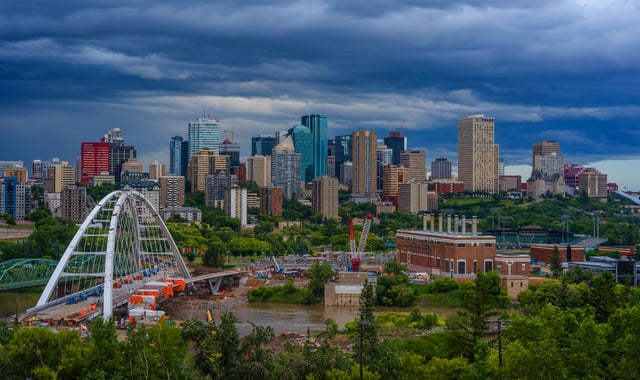
View of Edmonton's central business district from the south riverbank, over Walterdale Bridge.
Edmonton is the major economic centre for northern and central Alberta and a major centre for the oil and gas industry. As of 2014, the estimated value of major projects within the Edmonton Metropolitan Region was $57.8-billion, of which $34.4-billion are within the oil and gas, oil sands and pipeline sectors.[160]
Edmonton traditionally has been a hub for Albertan petrochemical industries, earning it the nickname "Oil Capital of Canada" in the 1940s.[161] Supply and service industries drive the energy extraction engine, while research develops new technologies and supports expanded value-added processing of Alberta's massive oil, gas, and oil sands reserves. These are reported to be the second-largest in the world, after Saudi Arabia.[162]
Much of the growth in technology sectors is due to Edmonton's reputation as one of Canada's premier research and education centres. Research initiatives are anchored by educational institutions such as the University of Alberta (U of A) as well as government initiatives underway at the Alberta Research Council and Edmonton Research Park. The U of A campus is home to the National Institute for Nanotechnology.[163]
During the 1970s and 1980s, Edmonton became a major financial centre, with both regional offices of Canada's major banks and locally based institutions opening.[164] However, the turmoil of the late-1980s economy radically changed the situation. Locally based operations such as Principal Trust and Canadian Commercial Bank[165] would fail, and some regional offices were moved to other cities. The 1990s saw a solidification of the economy, and Edmonton is now home to Canadian Western Bank, the only publicly traded Schedule I chartered bank headquarters west of Toronto.[166] Other major financial centres include ATB Financial, Servus Credit Union (formerly Capital City Savings), TD Canada Trust and Manulife Financial.[167]
Edmonton has been the birthplace of several companies that have grown to international stature.[168] The local retail market has also seen the creation of many successful store concepts, such as The Brick, Katz Group, AutoCanada, Boston Pizza, Pizza 73, Liquor Stores GP (which includes Liquor Depot, Liquor Barn, OK Liquor, and Grapes & Grains), Planet Organic, Shaw Communications, Empire Design, Running Room, Booster Juice, Earl's, Fountain Tire and XS Cargo.[169]
Edmonton's geographical location has made it an ideal spot for distribution and logistics. CN Rail's North American operational facility is located in the city, as well as a major intermodal facility that handles all incoming freight from the port of Prince Rupert in British Columbia.[170]
Retail
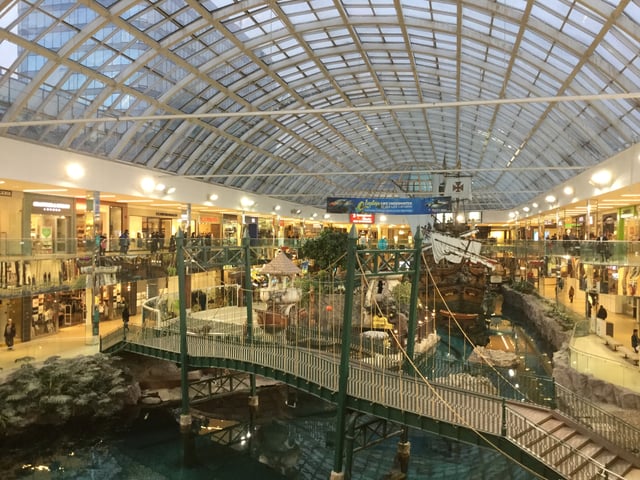
West Edmonton Mall is the largest shopping mall in the Americas.
Edmonton is home to several shopping malls and the largest mall in North America, West Edmonton Mall, which is also considered to be the 10th largest mall in the world.[171][172] Other mentionable malls include Bonnie Doon Shopping Centre, Edmonton City Centre (a combination of the former Edmonton Centre and Eaton Centre malls), Southgate Centre, Kingsway Mall, Northgate Centre, Riverview Crossing, Londonderry Mall, and Mill Woods Town Centre.[173]
Edmonton also has many big box shopping centres and power centres. Some of the major ones include South Edmonton Common (North America's largest open air retail development),[174] Mayfield Common, Westpoint, Skyview Power Centre, Terra Losa Centre, Oliver Square, Southpark Centre, The Meadows, Christy's Corner, Currents of Windermere, and Manning Village.[175]
In contrast to suburban centres, Edmonton has many urban retail locations. The largest of them all, Old Strathcona, includes many independent stores between 99 Street and 109 Street, on Whyte Avenue and in the surrounding area.[176] In and around Downtown Edmonton, there are a few shopping districts, including the Edmonton City Centre mall, Jasper Avenue, and 104 Street. Near Oliver, 124 Street is home to a significant number of retail stores. Edmonton is the Canadian testing ground for many American retailers, such as Bath & Body Works and Calvin Klein.[177]
Arts and culture
Many events are anchored in the downtown Arts District, centred around Churchill Square (named in honour of Sir Winston Churchill). On the south side of the river, the University district and Whyte Avenue contain theatres, concert halls, and various live music venues. The centrepiece of the square builds a life-size bronze statue of Churchill, unveiled by Lady Soames on May 24, 1989. It is a copy of a statue by Oscar Nemon.
Performing arts

Francis Winspear Centre for Music is a performing arts centre in downtown Edmonton. The Centre is home to the Edmonton Symphony Orchestra.
The Francis Winspear Centre for Music[178] opened in 1997 after years of planning and fundraising.[179] Described as one of the most acoustically perfect concert halls in Canada, it is home to the Edmonton Symphony Orchestra and hosts a wide variety of shows every year. It seats 1,932 patrons and houses the $3-million Davis Concert Organ, the largest concert organ in Canada.[180] Across 102 Avenue is the Citadel Theatre, named after The Salvation Army Citadel in which Joe Shoctor first started the Citadel Theatre Company in 1965. It is now one of the largest theatre complexes in Canada, with five halls, each specializing in different kinds of productions.[181] In 2015 the Citadel Theatre also became home to Catalyst Theatre. On the University of Alberta grounds is the 2,534-seat Northern Alberta Jubilee Auditorium, which had over a year of heavy renovations as part of the province's 2005 centennial celebrations. Both it and its southern twin in Calgary were constructed in 1955 for the province's golden jubilee and have hosted many concerts, musicals, and ballets. On the front of the building is a quote from Suetonius' Life of Augustus: "He found a city built of brick – left it built of marble."
The Old Strathcona neighbourhood is home to the Theatre District, which holds the ATB Financial Arts Barns (headquarters of the Edmonton International Fringe Festival), The Walterdale Playhouse, and the Varscona Theatre (base of operations for several theatre companies, including Teatro la Quindicina, Shadow Theatre, Die-Nasty, Plane Jane Theatre, and Grindstone Theatre!). Edmonton was named cultural capital of Canada in 2007.[182][183] The Ukrainian Dnipro Ensemble of Edmonton, along with other Ukrainian choirs such as the Ukrainian Male Chorus of Edmonton, helps preserve the Ukrainian musical culture within the parameters of the Canadian multicultural identity in Edmonton.[184]
Festivals
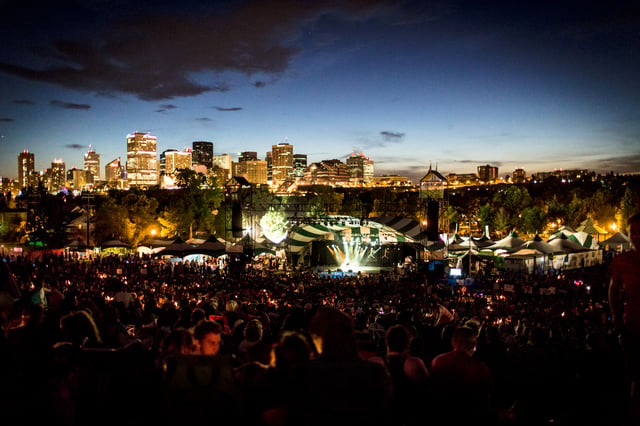
The Edmonton Folk Music Festival. Edmonton plays host to several large festivals each year.
Edmonton hosts several large festivals each year, contributing to its nickname, "Canada's Festival City".[1] Downtown Edmonton's Churchill Square host numerous festivals each summer. The Works Art & Design Festival, which takes place from late June to early July, showcases Canadian and international art and design from well-known award-winning artists as well as emerging and student artists. The Edmonton International Street Performer's Festival[185] takes place in mid-July and showcases street performance artists from around the world. The Edmonton International Jazz Festival takes place in late June and showcases artists performing jazz and other genres from around the world.[186]
Edmonton's main summer festival is K-Days, formerly Klondike Days, Capital Ex and originally the Edmonton Exhibition.[187] Founded in 1879, the Edmonton Exhibition was originally an annual fair and exhibition that eventually adopted a gold rush theme, becoming Klondike Days in the 1960s.[187] Northlands, the operators, renamed the festival "Edmonton's Capital Ex" or "Capital Ex" in 2006.[187] In 2012 Edmonton Northlands conducted a poll to rename the festival that resulted in changing the name to "K-Days".[187] Activities include carnival rides and fairways, music, trade shows, and daily fireworks.[188] The Canadian Finals Rodeo was held in Edmonton from 1974 to 2017, but moved to Red Deer in 2018 due to the closure of the Coliseum.[189]
The Edmonton International Fringe Festival, held in mid-August, is the largest fringe theatre festival in North America and second only to the Edinburgh Fringe Festival worldwide.[190] Also in August Edmonton hosts the Edmonton Folk Music Festival, one of the most successful and popular folk music festivals in North America.[191] Another major summer festival is the Edmonton Heritage Festival, an ethnocultural festival that takes place in William Hawrelak Park on the Heritage Day long weekend.[192] Many other festivals exist, such as Interstellar Rodeo,[193] the Free Will Shakespeare Festival, the Dragon Boat Festival,[194] The HarvestMoon Music and Arts Festival, the Whyte Avenue Art Walk, and the Edmonton International Film Festival.
Edmonton also hosts a number of winter festivals, including Deep Freeze: A Byzantine Winter Festival,[195] Ice on Whyte,[196] Flying Canoe Volant,[197] and the Silver Skate Festival, which is Edmonton's longest-running winter festival,[198] featuring snow sculptures, winter sports and horse-drawn sleighs.
Music
In the city's early days, music was performed in churches and community halls. Edmonton has a history of opera and classical music performance; both have been supported by a variety of clubs and associations. Edmonton's first major radio station, CKUA, began broadcasting music in 1927.[199] The city is a centre for music instruction; the University of Alberta began its music department in 1945, and MacEwan University opened a jazz and musical theatre program in 1980. Festivals of jazz, folk, and classical music are popular entertainment events in the city.[200]
The Edmonton Symphony Orchestra has existed under various incarnations since 1913. In 1952 the Edmonton Philharmonic and the Edmonton Pops orchestras amalgamated to form the 60-member modern version. The Orchestra performs at the Francis Winspear Centre for Music.[201]
The city also has a vibrant popular music scene, across genres including hip-hop, reggae, R&B, rock, pop, metal, punk, country and electronic. Notable past and present local musicians include Robert Goulet,[202] Tommy Banks, Stu Davis, Tim Feehan, Cadence Weapon, Kreesha Turner, The Smalls, SNFU, Social Code, Stereos, Ten Second Epic, Tupelo Honey, Mac DeMarco, Shout Out Out Out Out, Psyche, Purity Ring, The Wet Secrets, and Ruth B.[203]
Nightlife
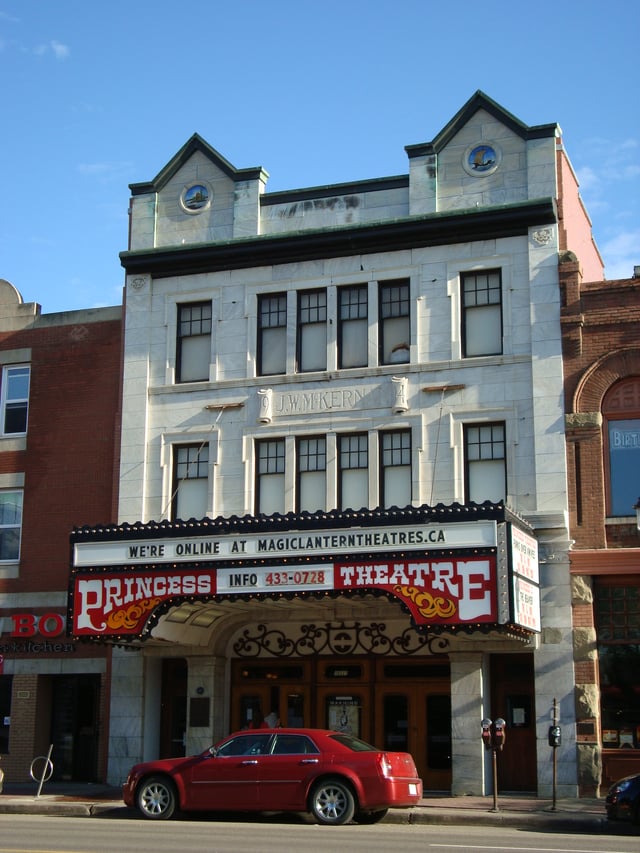
Opened in 1915, the Princess Theatre is the oldest cinema in the city.
There are several key areas of nightlife in Edmonton. The most popular is the Whyte Avenue (82 Avenue) strip, between 109 Street and 99 Street; it has the highest number of heritage buildings in Edmonton,[204] and bars, clubs, and restaurants throughout, but mostly west of Gateway Boulevard (103 Street). Once the heart of the town of Strathcona (annexed by Edmonton on February 1, 1912), it fell into disrepair during the middle of the 20th century.[205] Beginning in the 1970s, a coordinated effort to revive the area through a business revitalization zone produced an area rich with restored historical buildings and pleasant streetscapes.[110] Its proximity to the University of Alberta has led to a high number of restaurants, pubs, trendy clubs, and retail and specialty shops. This area also has two independent movie theatres, the Garneau and Princess, as well as several live theatre, music, and comedy venues.[206]
Downtown Edmonton has undergone a continual process of renewal and growth since the mid-1990s. Many buildings were demolished during the oil boom, starting in the 1960s and continuing into the 1980s, to make way for office towers. There have always been numerous pub-type establishments, hotel lounges, and restaurants. The past decade has seen a strong resurgence in more mainstream venues. Edmonton also has a high demand for pub crawl tours in the city. Various clubs are found along Edmonton's main street, Jasper Avenue. The Edmonton City Centre mall also houses a Landmark Cinemas movie theatre with nine screens. The nonprofit Metro Cinema[207] shows a variety of alternative or otherwise unreleased films every week.
West Edmonton Mall holds several after-hour establishments in addition to its many stores and attractions. Bourbon Street has numerous eating establishments; clubs and casinos can also be found within the complex. Scotiabank Theatre (formerly known as Silver City), at the west end of the mall, is a theatre with 12 screens and an IMAX.[21]
Attractions
Parkland and environment
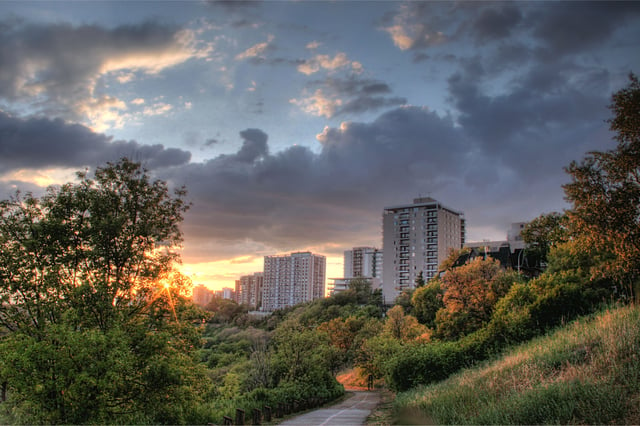
A trail in the North Saskatchewan River valley parks system
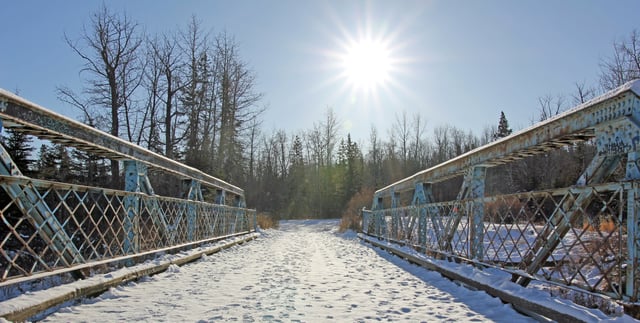
Entry to Larch Sanctuary
Edmonton's river valley constitutes the longest stretch of connected urban parkland in North America, and Edmonton has the highest amount of parkland per capita of any Canadian city; the river valley is 22 times larger than New York City's Central Park.[208] The river valley is home to various parks ranging from fully serviced urban parks to campsite-like facilities with few amenities. This main "Ribbon of Green" is supplemented by numerous neighbourhood parks located throughout the city, to give a total of 111 km2 (27,400 acres) of parkland.[208] Within the 7,400 ha (18,000 acres), 25 km (16 mi)-long river valley park system, there are 11 lakes, 14 ravines, and 22 major parks, and most of the city has accessible bike and walking trail connections.[209] These trails are also part of the 235 km (146 mi) Waskahegan walking trail. The City of Edmonton has named five parks in its River Valley Parks System in honour of each of "The Famous Five".[210]
Edmonton's streets and parklands also contain one of the largest remaining concentrations of healthy American elm trees in the world, unaffected by Dutch elm disease, which has wiped out vast numbers of such trees in eastern North America. Jack pine, lodgepole pine, white spruce, white birch, aspen, mountain ash, Amur maple, Russian olive, green ash, basswood, various poplars and willows, flowering crabapple, Mayday tree and Manitoba maple are also abundant; bur oak, silver maple, hawthorn and Ohio buckeye are increasingly popular. Other introduced tree species include white ash, blue spruce, Norway maple, red oak, sugar maple, common horse-chestnut, McIntosh apple, and Evans cherry.[211] Three walnut species – butternut, Manchurian walnut, and black walnut – have survived in Edmonton.[212]
Several golf courses, both public and private, are also located in the river valley; the long summer daylight hours of this northern city provide for extended play from early morning well into the evening.[213] Golf courses and the park system become a winter recreation area during this season, and cross-country skiing and skating are popular during the long winter. Four downhill ski slopes are located in the river valley as well, two within the city and two immediately outside.[214]
The Edmonton & Area Land Trust (EALT) is a charity focused on conserving natural areas in Edmonton and surrounding municipalities. Its first project in Edmonton was conserving Larch Sanctuary,[215] via a 59-acre Conservation Easement with the City, straddling Whitemud Creek south of 23rd Avenue, and containing the only oxbow lake in the City. EALT works with many organisations in Edmonton, and is currently working to conserve the 233 acres of Forest and Farmland[216] in a loop of the river in North East Edmonton.
A variety of volunteer opportunities exist for citizens to participate in the stewardship of Edmonton's parkland and river valley. Volunteer programs include River Valley Clean-up, Root for Trees, and Partner in Parks.[217] River Valley Clean-up engages volunteers to pick up hundreds of bags of litter each year.
Museums and galleries
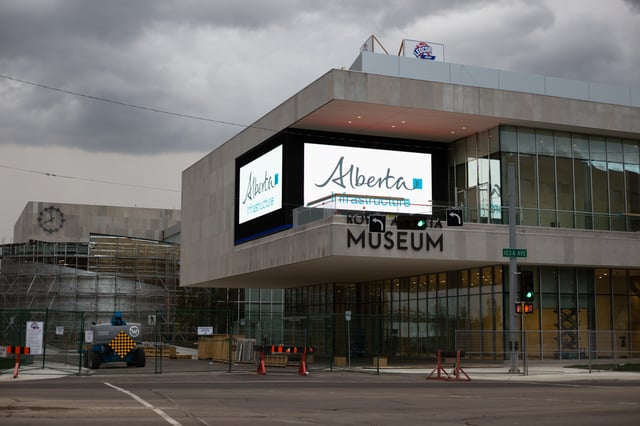
Construction for the Royal Alberta Museum's new building, which opened in early October 2018. The museum is the largest museum in Alberta by floorspace.
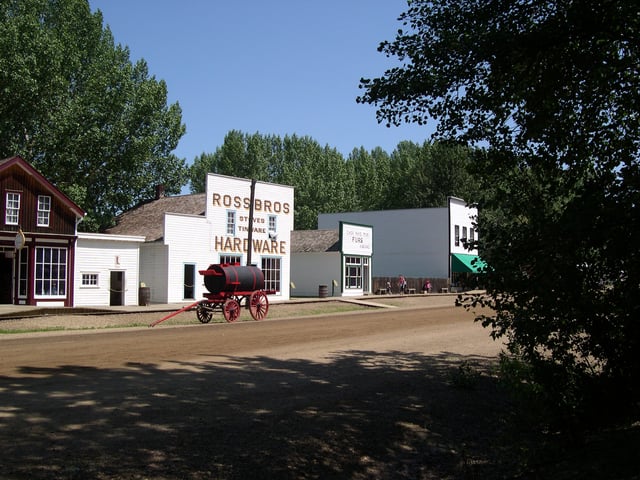
Fort Edmonton Park is Canada's largest living museum by area.
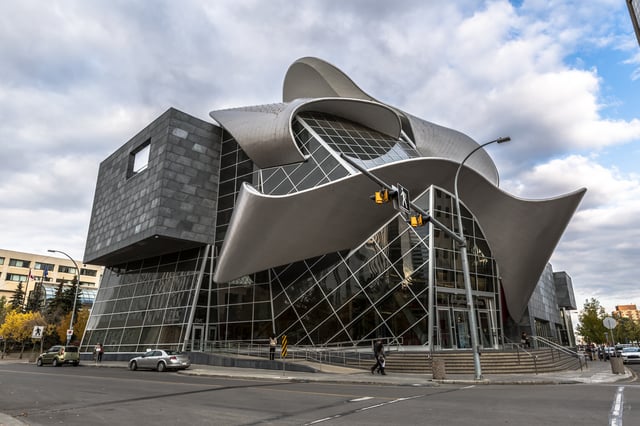
The Art Gallery of Alberta is Edmonton's largest art gallery.
There are many museums in Edmonton of various sizes.[218] The largest is the Royal Alberta Museum (RAM), which was formerly known as the Provincial Museum of Alberta until it was renamed in honour of Queen Elizabeth II's 2005 Alberta centennial visit. The RAM houses over 10 million objects in its collection and showcases the culture and practices of the diverse aboriginal tribes of the region. In 2018, the building relocated from its location in Glenora to a new building in downtown on 103A Avenue and 97 Street. The museum held a grand opening event and gave out 40,000 free tickets for its first few days of operation.[219]
The Telus World of Science is located in the Woodcroft neighbourhood northwest of the city centre. It opened in 1984 and has since been expanded several times. It contains five permanent galleries, one additional gallery for temporary exhibits, an IMAX theatre, a planetarium, an observatory, and an amateur radio station. The Edmonton Valley Zoo is in the river valley to the southwest of the city centre.[220]
The Alberta Aviation Museum, located in a hangar at the City Centre Airport, was built for the British Commonwealth Air Training Plan. Its collection includes both civilian and military aircraft, the largest of which are a Boeing 737 and two CF-101 Voodoos. It also has one of only 3 BOMARC missiles in Canada.
The Prince of Wales Armouries Heritage Centre[221] is home to the Loyal Edmonton Regiment Military Museum. The museum is dedicated to preserving the military heritage and the sacrifices made by the people of Edmonton and Alberta in general. The museum features two galleries and several smaller exhibits. The collection includes historic firearms, uniforms, souvenirs, memorabilia, military accoutrements, as well as a large photographic and archival collection spanning the pre-World War One period to the present. The museum features an exhibit on the role of the 49th Battalion, CEF in Canada's Hundred Days Offensive.
The Telephone Historical Centre is a telephone museum also located in the Prince of Wales Armouries Heritage Centre. In addition to a collection of artifacts tracing the history of the telephone, the museum has its own theatre featuring a brief film led by the robot Xeldon.[222]
The Alberta Railway Museum[223] is located in the rural northeast portion of the city. It contains a variety of locomotives and railroad cars from different periods, and includes a working steam locomotive. Since most of its exhibits are outdoors, it is only open between Victoria Day and Labour Day.
Fort Edmonton Park, Canada's largest living history museum, is located in the river valley southwest of the city centre. Edmonton's heritage is displayed through historical buildings (many of which are originals moved to the park), costumed historical interpreters, and authentic artifacts. In total, it covers the region's history from approximately 1795 to 1929 (represented by Fort Edmonton), followed chronologically by 1885, 1905, and 1920 streets, and a recreation of a 1920s midway. A steam train, streetcars, automobiles and horse-drawn vehicles may be seen in operation (and utilized by the public) around the park. The John Walter Museum and Historical Area (c. 1875 to 1901) is on the Canadian Register of Historic Places.[224] The University of Alberta operates its own internal Museums and Collections service.[225]
The Art Gallery of Alberta (AGA) is the city's largest single gallery. Formerly housed in an iconic 1970s Brutalist building designed by Don Bittorf,[226] the AGA collection had over 5,000 pieces of art. The former AGA building was demolished in July 2007 to make way for construction of a new facility designed by Randall Stout. It was estimated to cost over $88-million and the amount that Edmonton City Council donated towards its construction was met with some controversy. The AGA officially opened on January 31, 2010.[227] Independent galleries can be found throughout the city, especially along the 124 Street/Jasper Avenue corridor, known as the "gallery walk".[228]
Sports and recreation
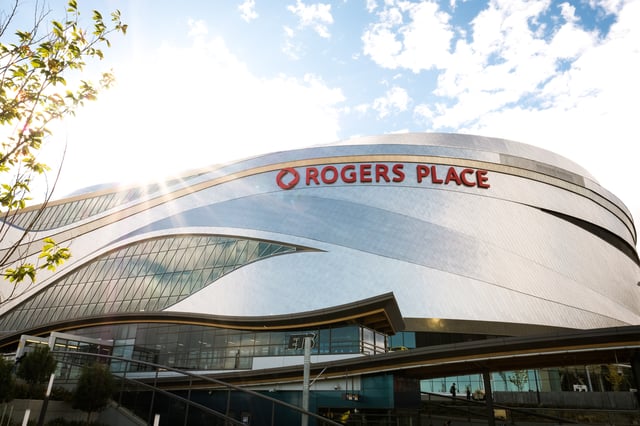
Rogers Place is a multi-use indoor arena, and the present home arena for the NHL's Edmonton Oilers.
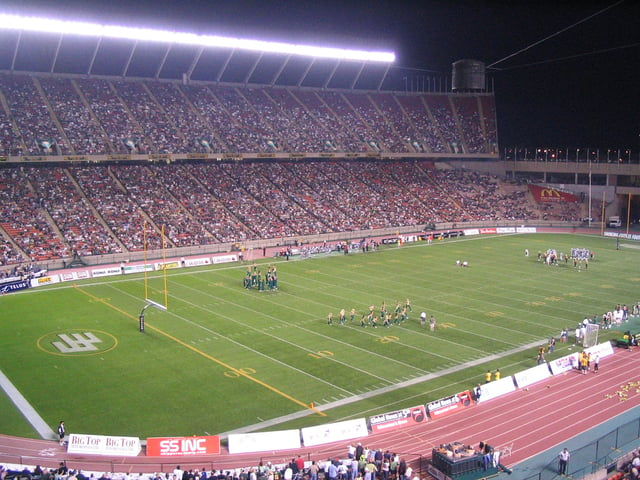
Commonwealth Stadium is an open-air multi-purpose stadium. Opened in 1978 for the 1978 Commonwealth Games, the facility is also used as the home stadium for CFL's Edmonton Eskimos.
Edmonton has a number of professional sports teams,[229] including the Edmonton Eskimos of the Canadian Football League, Edmonton Oilers of the National Hockey League, and FC Edmonton of the Canadian Premier League. Junior sports clubs include the Edmonton Huskies and Edmonton Wildcats of the Canadian Junior Football League and the Edmonton Oil Kings of the Western Hockey League. Venues for Edmonton's professional and junior sports teams include Commonwealth Stadium (Eskimos), Argyll Velodrome, Rogers Place (Oilers and Oil Kings), Edmonton Ballpark (Prospects), the Universiade Pavilion (Energy), and Clarke Stadium (FC Edmonton, Huskies and Wildcats).
Edmonton's teams have rivalries with Calgary's teams and games between Edmonton and Calgary teams are often referred to as the Battle of Alberta.
Past notable hockey teams in Edmonton include: the original junior hockey incarnation of the Edmonton Oil Kings, with multiple league and national Memorial Cup championships playing in the Western Hockey League; the Edmonton Flyers, with multiple Lester Patrick Cups and one national Allan Cup, and; the Edmonton Roadrunners of the American Hockey League. Other past notable sports teams include; the Edmonton Grads, a women's basketball team with 108 local, provincial, national, and international titles and the world champions for 17 years in a row; the Edmonton Trappers, a Triple-A level baseball team with multiple division and league titles in the Pacific Coast League, and; the Edmonton Rush, a box lacrosse team with one league championship.
Local university-level sports teams include the U of A Golden Bears, the U of A Pandas, the NAIT Ooks, and the MacEwan Griffins. Local amateur teams, among others, include the Edmonton Gold of the Rugby Canada Super League and two flat track roller derby leagues: Oil City Roller Derby[230] and E-Ville Roller Derby.[231]
From 2005 to 2012, Edmonton hosted an annual circuit on the Indy Racing League known as the Edmonton Indy. Other past sporting events hosted by Edmonton include the 1978 Commonwealth Games, the 1983 World University Games (Universiade), the 2001 World Championships in Athletics, the 2002 World Ringette Championships, the 2005 World Master Games,[234] the 2006 Women's Rugby World Cup, the 2007 and 2014 FIFA U-20 Women's World Cup, the 2015 FIFA Women's World Cup,[235] and the CN Canadian Women's Open. Edmonton shared hosting duties with Calgary for the 2012 World Junior Ice Hockey Championships. Edmonton is one of the venues for the 2026 FIFA World Cup[236]
| Club | Type | League | Venue | Established | Championships |
| Edmonton Eskimos | Canadian football | Canadian Football League | Commonwealth Stadium | 1949 | 14 |
| Edmonton Oilers | Ice hockey | National Hockey League | Rogers Place | 1972 | 5 |
| FC Edmonton | Soccer | Canadian Premier League | Clarke Stadium | 2011 | 0 |
| Edmonton Stingers | Basketball | Canadian Elite Basketball League | Edmonton Expo Centre | 2018 | 0 |
| Club | Type | League | Venue | Established | Championships |
| Edmonton Huskies | Canadian football | Canadian Junior Football League | Clarke Stadium | 1947 | 5 |
| Edmonton Wildcats | Canadian football | Canadian Junior Football League | Clarke Stadium | 1948 | 3 |
| Edmonton Prospects | Baseball | Western Major Baseball League | RE/MAX Field | 2005 | 0 |
| Edmonton Drillers | Indoor soccer | Canadian Major Indoor Soccer League | Servus Credit Union Place (St. Albert) | 2006 | 3 |
| Edmonton Oil Kings | Ice hockey | Western Hockey League | Rogers Place | 2007 | 2 |
Government
City council
The Edmonton City Council consists of a mayor and twelve councillors serving four-year terms. Each councillor is elected in a ward (electoral district); the mayor is elected at-large. The elections are non-partisan. Council has the responsibility of approving the city's budget, and develops laws and policies intended to promote the health and safety of Edmonton residents. The Council passes all legislation related to the city's police, firefighting, parks, libraries, and electricity, water supply, solid waste, and drainage utilities.
On July 22, 2009, City Council adopted an electoral system that divides Edmonton into 12 wards, instead of the previous two for each of six wards. This system came into effect with the following election in October 2010.[237] The most recent election was held in October 2017, and elected members to a four-year term.
Provincial politics

Edmonton is home to the Alberta Legislature Building, the meeting place for the Legislative Assembly of Alberta.
Edmonton is the capital of the province of Alberta and holds all main provincial areas of government such as the Provincial Legislature of Alberta. The Edmonton Metropolitan Region is represented by 20 MLAs, one for each provincial electoral district. Many of these boundaries have been changed, adjusted and renamed while the city has grown.[238] In the current 30th Alberta Legislature nearly all of Edmonton's districts are represented by members from the Opposition Alberta New Democratic Party. One of the MLAs, Rachel Notley, is also the Leader of the Opposition.
Policing

Edmonton Police Service vehicle on patrol.
The Edmonton census metropolitan area (CMA) had a crime severity index of 84.5 in 2013, which is higher than the national average of 68.7.[241] Its crime severity index was the fifth-highest among CMAs in Canada behind Regina, Saskatoon, Kelowna and Vancouver.[241] Edmonton had the fourth-most homicides in 2013 at 27.[241]
Military
Edmonton is home to 1 Canadian Mechanized Brigade Group (1 CMBG), the Regular Force army brigade group of Land Force Western Area of the Canadian Army. Units in 1 CMBG include Lord Strathcona's Horse (Royal Canadians), 1 Combat Engineer Regiment, two of the three regular force battalions of Princess Patricia's Canadian Light Infantry, and various headquarters, service, and support elements. Although not part of 1 CMBG, 408 Tactical Helicopter Squadron and 1 Field Ambulance are located with the brigade group. All of these units are located at Lancaster Park, immediately north of the city. From 1943, as CFB Namao (now CFB Edmonton/Edmonton Garrison), it was a major air force base.[242] In 1996, all fixed-wing aviation units were transferred to CFB Cold Lake.
The Canadian Airborne Training Centre had been located in the city in the 1980s. The move of 1 CMBG and component units from Calgary occurred in 1996 in what was described as a cost-saving measure.[243] The brigade had existed in Calgary since the 1950s, and Lord Strathcona's Horse had traditionally been a Calgary garrison unit dating back to before World War I.
Edmonton also has a large army reserve element from 41 Canadian Brigade Group (41 CBG), including The Loyal Edmonton Regiment (4th Battalion, Princess Patricia's Canadian Light Infantry); 41 Combat Engineer Regiment; HQ Battery, 20th Field Artillery Regiment; and B Squadron of The South Alberta Light Horse, one of Alberta's oldest army reserve units. Despite being far from Canada's coasts, Edmonton is also the home of HMCS Nonsuch,[244] a naval reserve division. There are numerous cadet corps[245] of the different elements (naval, army and air force) within Edmonton as well.
Infrastructure
Transportation
Aviation
Edmonton is a major air transportation gateway to northern Alberta and northern Canada.[31] The Edmonton International Airport (EIA) is the main airport serving the city.
The EIA provides passenger service to destinations in the United States, Europe, Mexico, and the Caribbean. The EIA is located within Leduc County, adjacent to the City of Leduc and the Nisku Industrial Business Park. With direct air distances from Edmonton to places such as London in Europe being shorter than to other main airports in western North America,[246] Edmonton Airports is working to establish a major container shipping hub called Port Alberta.[247]
Rail
Edmonton serves as a major transportation hub for Canadian National Railway, whose North American operations management centre is located at their Edmonton offices. It is also tied into the Canadian Pacific Railway network, which provides service from Calgary to the south and extends northeast of Edmonton to serve Alberta's Industrial Heartland.
Inter-city rail passenger rail service is provided by Via Rail's premier train, the Canadian, as it travels between Vancouver, British Columbia, and Toronto, Ontario. Passenger trains stop at the Edmonton railway station three days a week in both directions. The train connects Edmonton to multiple stops in British Columbia, Alberta, Saskatchewan, Manitoba, and Ontario.[248]
Public transit
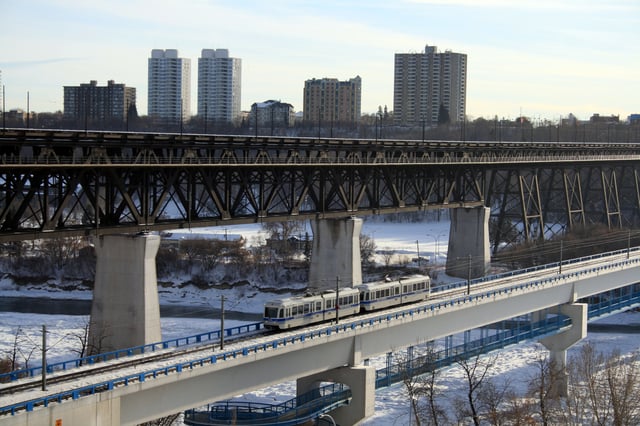
Edmonton Light Rail Transit train crossing the North Saskatchewan River. The light rail system is operated by the Edmonton Transit Service.
The Edmonton Transit Service (ETS) is the city's public transit agency, operating the Edmonton Light Rail Transit (LRT) line as well as a fleet of buses.[249] As of 2009 there were 354,440 boardings per day[250][251] (in a population of 1,034,945[252]). There are approximately 280,000 ETS bus boardings, 54,000 LRT boardings, and 3,500 paratransit boardings per weekday.[250]
Scheduled LRT service began on April 23, 1978, with five extensions of the single line completed since.[256] The original Edmonton line is considered to be the first "modern" light rail line in North America (i.e., built from scratch, rather than being an upgrade of an old system). It introduced the use of German-designed rolling stock that subsequently became the standard light rail vehicle of the United States.[256] The Edmonton "proof-of-payment" fare collection system adopted in 1980 – modelled after European ticket systems – became the North American transit industry's preferred approach for subsequent light rail projects.[257] The four-year South LRT extension was opened in full on April 24, 2010, which sees trains travelling to Century Park[258] (located at 23 Avenue and 111 Street), making stops at South Campus and Southgate Centre along the way.[258] A line to the Northern Alberta Institute of Technology in north-central Edmonton using the same high floor technology of the existing system opened September 6, 2015. Edmonton is also expanding the LRT to Mill Woods (the southeast) by 2020 and to Lewis Farms (the west) thereafter using low floor technology.
Roads
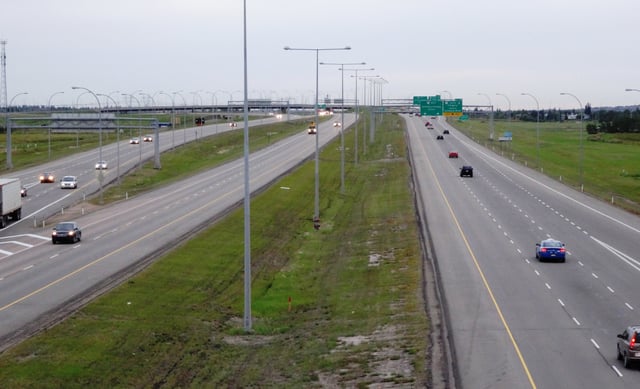
Anthony Henday Drive from 91 Street in Edmonton. The freeway is the main ring road for the city.
A largely gridded system forms most of Edmonton's street and road network.[259] The address system is mostly numbered, with streets running south to north and avenues running east to west. In built-up areas built since the 1950s, local streets and major roadways generally do not conform to the grid system. Major roadways include Kingsway, Yellowhead Trail (Highway 16), Whitemud Drive and Anthony Henday Drive.
The major roads connecting to other communities elsewhere in Alberta, British Columbia, and Saskatchewan are the Yellowhead Highway to the west and east and Highway 2 (Queen Elizabeth II Highway) to the south.[260][261]
Trail system
There is an extensive multi-use trail system for bicycles and pedestrians throughout the city; however, most of this is within the river valley parkland system.[262]
Electricity and water
Edmonton's first power company established itself in 1891 and installed streetlights along the city's main avenue, Jasper Avenue. The power company was bought by the Town of Edmonton in 1902 and remains under municipal ownership today as EPCOR. Also in charge of water treatment, in 2002 EPCOR installed the world's largest ultraviolet (UV) water treatment or ultraviolet disinfection system at its E. L. Smith Water Treatment Plant.[263]
Waste disposal
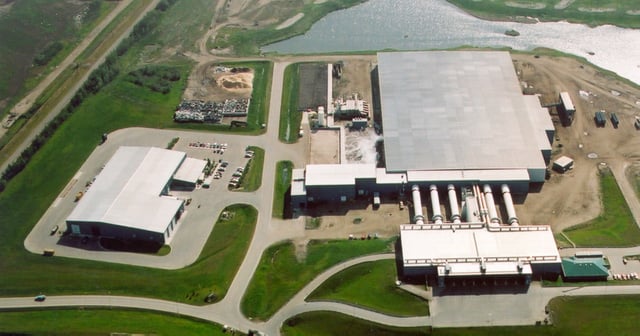
The Edmonton Composting Facility is the largest co-composting facility in North America by volume and capacity.
The Edmonton Composting Facility, the largest of its type in the world, is also the largest stainless steel building in North America.[264] Among the innovative uses for the city's waste includes a Christmas tree recycling program. The trees are collected each January and put through a woodchipper; this material is used as an addition to the composting process. In addition, the wood chips absorb much of the odour produced by the compost by providing a biofilter element to trap odour causing gaseous results of the process.[265]
Together, the Waste Management Centre and Wastewater Treatment plant are known as the Edmonton Waste Management Centre of Excellence. Research partners include the University of Alberta, the Alberta Research Council, the Northern Alberta Institute of Technology, and Olds College.[266]
Health care
There are four main hospitals serving Edmonton: University of Alberta Hospital, Royal Alexandra Hospital, Misericordia Community Hospital, and Grey Nuns Community Hospital.[267] Other area hospitals include Sturgeon Community Hospital in St. Albert, Leduc Community Hospital in Leduc, Westview Health Centre in Stony Plain, and Fort Saskatchewan Community Hospital in Fort Saskatchewan. Dedicated psychiatric care is provided at the Alberta Hospital. The Northeast Community Health Centre offers a 24-hour emergency room with no inpatient ward services. The University of Alberta Hospital is the centre of a larger complex of hospitals and clinics located adjacent to the university campus which comprises the Stollery Children's Hospital, Mazankowski Alberta Heart Institute, Cross Cancer Institute, Zeidler Gastrointestinal Health Centre, Ledcor Clinical Training Centre, and Edmonton Clinic. Several health research institutes, including the Heritage Medical Research Centre, Medical Sciences Building, Katz Group Centre for Pharmacy and Health Research, and Li Ka Shing Centre for Health Research Innovation, are also located at this site. A similar set-up is also evident at the Royal Alexandra Hospital, which is connected to the Lois Hole Hospital for Women and Orthopaedic Surgery Centre. All hospitals are under the administration of Alberta Health Services, although Misericordia and Grey Nuns are run separately by Covenant Health.[268]
Education
Primary and secondary
Edmonton has three publicly funded school boards (districts) that provide kindergarten and grades 1–12. The vast majority of students attend schools in the two large English-language boards: Edmonton Public Schools, and the separate Edmonton Catholic School District.[269] Also, since 1994, the Francophone minority community has had their own school board based in Edmonton, the Greater North Central Francophone Education Region No. 2, which includes surrounding communities. The city also has a number of public charter schools that are independent of any board. All three school boards and public charter schools are funded through provincial grants and property taxes.
Some private schools exist as well, including Edmonton Academy,[270] Progressive Academy[271] and Tempo School.[272] The Edmonton Society for Christian Education[273] and Millwoods Christian School (not part of the former) used to be private schools; however, both have become part of Edmonton Public Schools as alternative programs.[274][275]
Both the Edmonton Public Schools and the Edmonton Catholic School District provide support and resources for those wishing to homeschool their children.[276]
Post-secondary
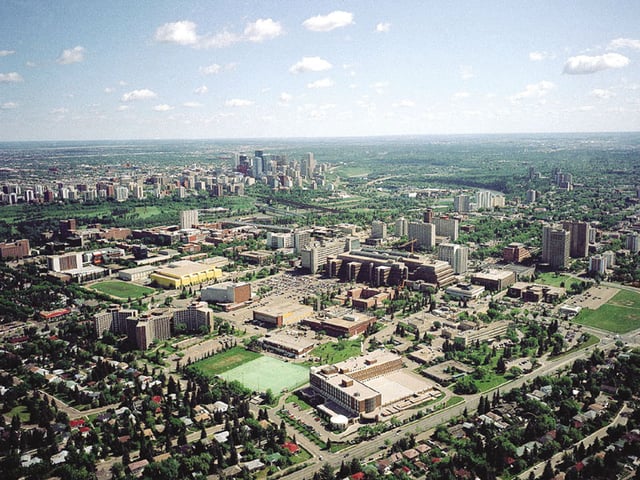
The University of Alberta overlooks the North Saskatchewan River and downtown Edmonton.
Those post-secondary institutions based in Edmonton that are publicly funded include Concordia University of Edmonton, MacEwan University, The King's University, NorQuest College, the Northern Alberta Institute of Technology (NAIT) and the University of Alberta (U of A).[277] The publicly funded Athabasca University and the University of Lethbridge[277] also have campuses in Edmonton.[278][279]
The U of A is a board-governed institution[280] that has an annual revenue of over one billion dollars.[281] In 2011/12, the university had over 38,000 students enrolled within nearly 400 undergraduate, graduate and professional programs, as well as over 15,000 students enrolled in its faculty of extension.[282] The U of A is also home to the second-largest research library system in Canada.[283]
In 2010/11, MacEwan University had a total student population of over 43,000 students, including nearly 14,000 full-time students, enrolled in programs offering bachelor's degrees, university transfers, diplomas and certificates.[284] NAIT has an approximate total of 61,200 students enrolled in more than 200 programs[285] while NorQuest College has approximately 8,500 students enrolled in various full-time, part-time and continuing education programs.[286]
Media
Edmonton has seven local broadcast television stations shown on basic cable TV or over-the-air, with the oldest broadcasters in the city being CTV (1961) and CBC (1954).[289] Most of Edmonton's conventional television stations have made the switch to over-the-air digital broadcasting. The cable television providers in Edmonton are Telus (for IPTV) and Shaw Cable. Twenty-one FM and eight AM radio stations are based in Edmonton.[290]
Edmonton has two large-circulation daily newspapers, the Edmonton Journal and the Edmonton Sun. The Journal, established in 1903 and owned by the Postmedia Network, has a daily circulation of 112,000, while the Sun, established in 1978 and owned by Sun Media, has a circulation of 55,000.[291] The Journal no longer publishes a Sunday edition as of July 2012.[292]
There is one free daily newspaper in the city, Metro.[293] The magazine Vue Weekly is published on a weekly basis and focuses on alternative news.[294] The Edmonton Examiner is a citywide community-based paper also published weekly.[295] There are also a number of smaller weekly and community newspapers.
Sister cities
Edmonton has five sister cities, with one American city listed by Sister Cities International.[296][297] Edmonton was Nashville's first sister city and in 2015, the cities celebrated the 25th anniversary of their partnership. In 2014 and 2015, Nashville Mayor Karl Dean visited Edmonton during the Canadian Country Music Awards and the Edmonton Folk Music Festival. At the Folk Festival, Mayor Dean addressed the crowd of 20,000 and together with civic and arts leaders, celebrated the 25th anniversary of our sister city twinning. In August 2015, more than 150 Canadians visited Nashville to attend native son Brett Kissel's Grand Ole Opry debut and to meet with Sister Cities representatives.[298] In November 2015, Doug Hoyer and Jeremy Witten represented Edmonton at World of Friendship, Nashville's annual sister cities celebration.[299]
See also
List of cities in Alberta
List of communities in Alberta
List of mayors of Edmonton
List of people from Edmonton
List of tallest buildings in Edmonton
Edmonton Federation of Community Leagues





